Related Research Articles

Wrist drop is a medical condition in which the wrist and the fingers cannot extend at the metacarpophalangeal joints. The wrist remains partially flexed due to an opposing action of flexor muscles of the forearm. As a result, the extensor muscles in the posterior compartment remain paralyzed.
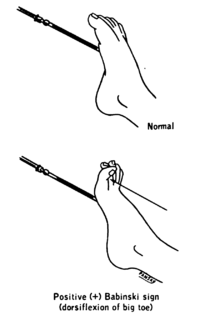
The plantar reflex is a reflex elicited when the sole of the foot is stimulated with a blunt instrument. The reflex can take one of two forms. In healthy adults, the plantar reflex causes a downward response of the hallux (flexion). An upward response (extension) of the hallux is known as the Babinski response or Babinski sign, named after the neurologist Joseph Babinski. The presence of the Babinski sign can identify disease of the spinal cord and brain in adults, and also exists as a primitive reflex in infants.
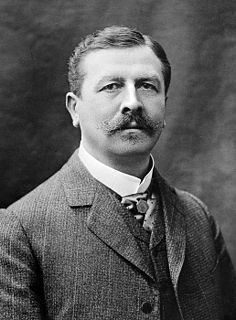
Joseph Jules François Félix Babinski was a French-Polish professor of neurology. He is best known for his 1896 description of the Babinski sign, a pathological plantar reflex indicative of corticospinal tract damage.
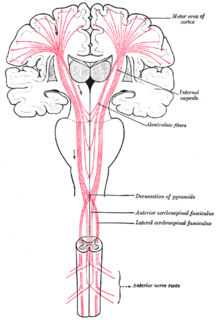
An upper motor neuron lesion Is an injury or abnormality that occurs in the neural pathway above the anterior horn cell of the spinal cord or motor nuclei of the cranial nerves. Conversely, a lower motor neuron lesion affects nerve fibers traveling from the anterior horn of the spinal cord or the cranial motor nuclei to the relevant muscle(s).

Upper motor neurons (UMNs) is a term introduced by William Gowers in 1886. They are found in the cerebral cortex and brainstem and carry information down to activate interneurons and lower motor neurons, which in turn directly signal muscles to contract or relax. UMNs in the cerebral cortex are the main source of voluntary movement.

The extensor digitorum muscle is a muscle of the posterior forearm present in humans and other animals. It extends the medial four digits of the hand. Extensor digitorum is innervated by the posterior interosseous nerve, which is a branch of the radial nerve.
Primitive reflexes are reflex actions originating in the central nervous system that are exhibited by normal infants, but not neurologically intact adults, in response to particular stimuli. These reflexes are suppressed by the development of the frontal lobes as a child transitions normally into child development. These primitive reflexes are also called infantile, infant or newborn reflexes.
Hoffmann's reflex is a neurological examination finding elicited by a reflex test which can help verify the presence or absence of issues arising from the corticospinal tract. It is named after neurologist Johann Hoffmann. Usually considered a pathological reflex in a clinical setting, the Hoffmann's reflex has also been used as a measure of spinal reflex processing (adaptation) in response to exercise training.
The Chaddock reflex is a diagnostic reflex similar to the Babinski reflex. Chaddock's sign is present when stroking of the lateral malleolus causes extension of the great toe, indicating damage to the corticospinal tract.
Brissaud's reflex is a clinical sign in which stroking the sole of the foot elicits contraction of tensor fasciae latae. This can occur when there is no movement of the toes, and is part of the extensor plantar response.
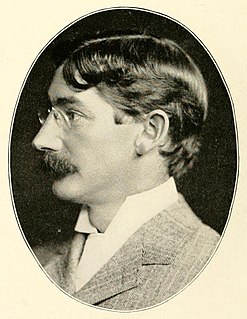
Charles Gilbert Chaddock was an American neurologist, psychiatrist, and translator. He is remembered for describing the Chaddock reflex and is credited with the coinage of the terms bisexuality, heterosexuality, and homosexuality in the English language.
Stransky's sign is a clinical sign in which vigorous abduction followed by the sudden release of the little toe causes an extensor plantar reflex. It is found in patients with pyramidal tract lesions, and is one of a number of Babinski-like responses.
Gonda's sign is a clinical sign in which flexing and then suddenly releasing the fourth toe elicits an extensor plantar reflex. It is found in patients with pyramidal tract lesions, and is one of a number of Babinski-like responses.It is named after the Ukrainian neuropsychiatrist Viktor Gonda (1889–1959), who discovered it sometime in the mid-1930s while he was practicing in the United States. Gonda was one of the strong proponents of electrotherapy to cure psychiatric illnesses.
Gordon's sign is a clinical sign in which squeezing the calf muscle elicits an extensor plantar reflex. It is found in patients with pyramidal tract lesions, and is one of a number of Babinski-like responses.
Moniz sign is a clinical sign in which forceful passive plantar flexion of the ankle elicits an extensor plantar reflex. It is found in patients with pyramidal tract lesions, and is one of a number of Babinski-like responses.It is named after Portuguese neurologist António Egas Moniz.
Strümpell's sign is a clinical sign in which the patient's attempt to flex the knee against resistance elicits an extensor plantar reflex. It is found in patients with pyramidal tract lesions, and is one of a number of Babinski-like responses.
Throckmorton's reflex is a clinical sign in which pressure over the dorsal side of the metatarsophalangeal joint of the big toe elicits a plantar reflex. It is found in patients with pyramidal tract lesions, and is one of a number of Babinski-like responses.
Schaeffer's sign is a clinical sign in which squeezing the Achilles tendon elicits an extensor plantar reflex. It is found in patients with pyramidal tract lesions, and is one of a number of Babinski-like responses.
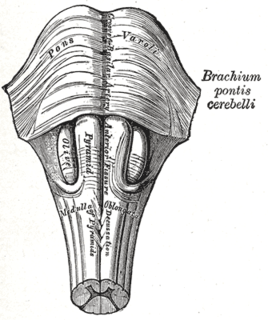
Babinski–Nageotte syndrome is an alternating brainstem syndrome. It occurs when there is damage to the dorsolateral or posterior lateral medulla oblongata, likely syphilitic in origin. Hence it is also called the alternating medulla oblongata syndrome.
References
- ↑ Kumar SP, Ramasubramanian D (December 2000). "The Babinski sign--a reappraisal". Neurol India. 48 (4): 314–18. PMID 11146592 . Retrieved 2009-04-13.